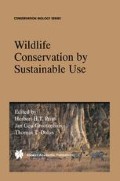Summary
This case study is an analysis of the financial viability of wildlife conservation at the Lewa Wildlife Conservancy (LWC) in Kenya. In the last decade the form of land use was changed from cattle ranching to wildlife conservation. In 1994 the entire conservation area was fenced. Currently the LWC is strongly dependent on donor contributions to sustain the on-going programmes, in particular the protection of both species of rhinoceros and Grevy’s zebra. In 1996, 29% of the yearly running expenses were financed by the profit centres developed on the Conservancy and 71% were covered by donations. The main source of income was tourism, followed by wildlife sales (cropping) and farming.
Due to the high cost of the endangered species programme, the current concept of wildlife conservation is not financially viable, nor is cattle ranching. The Conservancy’s tourism policy does not enable the costs of protection of endangered species to be covered. Potential trophy hunting would reduce the deficit but cannot compensate for the high costs of the sustained programmes.
This case study demonstrates that financial independence will be very difficult to achieve. A drastic cost reduction or termination of the endangered species programme, together with a change in the current tourism policy, needs to be considered.
On the other hand the contribution of the LWC to national and international conservation, protection of endangered species and the world’s biodiversity needs to be recognised. The LWC with its professional security organisation also plays an important role in the security of the area where it is located and for which it has not been financially supported.
Access this chapter
Tax calculation will be finalised at checkout
Purchases are for personal use only
Preview
Unable to display preview. Download preview PDF.
References
Bell, R.H.V. and J.E. Clarke (1985). Funding And Financial Control. In: Bell and Mcshane-Caluzi (Eds.) Conservation and Wildlife Management in Africa, p. 317–353. US Peace Corps, Washington DC, United States.
Bos, D., J. Grootenhuis and H. Prins (1996). Financial Feasibility of Game Cropping in Machakos District, Kenya. In: H.H.T. Prins et al. (ed.) Wildlife Conservation by Sustainable Use, p. 277–294, Kluwer Academic Publishers, Norwell, MA.
Cumming, D.H.M., R.B. Martin and R.D. Taylor (1984). The Status And Conservation Of Africa’ss Elephants And Rhinos. IUCN, Gland, Switzerland.
Earnshaw, A. and L. Emerton (1998). The Economics of Wildlife Tourism: Theory and Reality for Landholders in Africa. In: H.H.T. Prins et al. (ed.) Wildlife Conservation by Sustainable Use, p. 315–334, Kluwer Academic Publishers, Norwell, MA.
Heath, B. (1998). Ranching: An Economic Yardstick. In: H.H.T. Prins et al. (ed.) Wildlife Conservation by Sustainable Use, p. 21–34, Kluwer Academic Publishers, Norwell, MA.
Hopcraft, D. (1998). Wildlife Land Use and the Great Experiment. In: H.H.T. Prins et al. (ed.) Wildlife Conservation by Sustainable Use, p. 267–276, Kluwer Academic Publishers, Norwell, MA.
Hurt, R. and P. Ravn (1998). Hunting and its Benefits: An Overview of Hunting in Africa with Special Reference to Tanzania. In: H.H.T. Prins et al. (ed.) Wildlife Conservation by Sustainable Use, p. 295–314, Kluwer Academic Publishers, Norwell, MA.
Jachmann, M. and M. Billiouw (1997). Elephant Poaching And Law Enforcement In The Central Luangwa Valley. Journal of Applied Ecology 34, 233–244.
Leader-Williams, N. and S.D. Albon (1988). Allocation Of Resources For Conservation. Nature 336, 533–535.
Author information
Authors and Affiliations
Editor information
Editors and Affiliations
Rights and permissions
Copyright information
© 2000 Springer Science+Business Media New York
About this chapter
Cite this chapter
Szapary, P. (2000). The Lewa Wildlife Conservancy in Kenya: A Case Study. In: Prins, H.H.T., Grootenhuis, J.G., Dolan, T.T. (eds) Wildlife Conservation by Sustainable Use. Conservation Biology Series, vol 12. Springer, Dordrecht. https://doi.org/10.1007/978-94-011-4012-6_4
Download citation
DOI: https://doi.org/10.1007/978-94-011-4012-6_4
Publisher Name: Springer, Dordrecht
Print ISBN: 978-94-010-5773-8
Online ISBN: 978-94-011-4012-6
eBook Packages: Springer Book Archive

